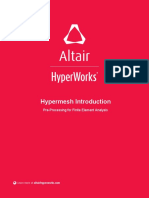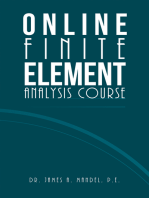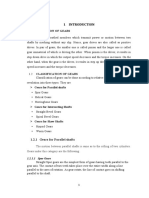Material Damage and Failure in Abaqus
Uploaded by
Venu KishoreMaterial Damage and Failure in Abaqus
Uploaded by
Venu KishoreABAQUS/Explicit: Advanced Topics
Lecture 9
Material Damage and Failure
Copyright 2005 ABAQUS, Inc.
ABAQUS/Explicit: Advanced Topics
L9.2
Overview
Progressive Damage and Failure Damage Initiation for Ductile Metals Damage Evolution Element Removal Failure in Fasteners
Copyright 2005 ABAQUS, Inc.
ABAQUS/Explicit: Advanced Topics
Progressive Damage and Failure
Copyright 2005 ABAQUS, Inc.
ABAQUS/Explicit: Advanced Topics
L9.4
Progressive Damage and Failure
ABAQUS offers a general capability for modeling progressive damage and failure in engineering structures. Material failure refers to the complete loss of load carrying capacity that results from progressive degradation of the material stiffness. Stiffness degradation is modeled using damage mechanics. Progressive damage and failure can be modeled in: Bulk materials Continuum constitutive behavior used in conjunction with the Mises, Johnson-Cook, Hill, or Drucker-Prager plasticity models This is the primary focus of this lecture. Interface materials Cohesive elements with a traction-separation law This was discussed in Lecture 7, Constraints and Connections.
Copyright 2005 ABAQUS, Inc.
ABAQUS/Explicit: Advanced Topics
L9.5
Progressive Damage and Failure
Two distinct types of bulk material failure can be modeled with ABAQUS/Explicit Ductile fracture of metals Void nucleation, coalescence, and growth Shear band localization Necking instability in sheet-metal forming Forming Limit Diagrams Marciniak-Kuczynski (M-K) criterion Damage in sheet metals is not discussed further in this seminar.
Copyright 2005 ABAQUS, Inc.
ABAQUS/Explicit: Advanced Topics
L9.6
Progressive Damage and Failure
Components of material definition Undamaged constitutive behavior (e.g., elastic-plastic with hardening) Damage initiation (point A) Damage evolution (path AB) Choice of element removal (point B)
Keywords *MATERIAL *ELASTIC *PLASTIC *DAMAGE INITIATION,CRITERION=criterion *DAMAGE EVOLUTION *SECTION CONTROLS, ELEMENT DELETION=YES Typical material response showing progressive damage
Undamaged response
A
Damaged response
B
Multiple damage definitions are allowed
Copyright 2005 ABAQUS, Inc.
ABAQUS/Explicit: Advanced Topics
Damage Initiation Criteria for Ductile Metals
Copyright 2005 ABAQUS, Inc.
ABAQUS/Explicit: Advanced Topics
L9.8
Damage Initiation Criteria for Ductile Metals
Damage initiation defines the point of initiation of degradation of stiffness It is based on user-specified criteria Ductile or shear It does not actually lead to damage unless damage evolution is also specified Output variables associated with each criterion Useful for evaluating the severity of current deformation state Output
DMICRT
Ductile Shear
DMICRT 1 indicates damage has initiated
Copyright 2005 ABAQUS, Inc.
Different damage initiation criteria on an aluminum double-chamber profile
ABAQUS/Explicit: Advanced Topics
L9.9
Damage Initiation Criteria for Ductile Metals
Ductile criterion: Appropriate for triggering damage due to nucleation, growth, and coalescence of voids The model assumes that the equivalent plastic strain at the onset of damage is a function of stress triaxiality and strain rate.
Pressure stress
Stress triaxiality = p / q
Mises stress
The ductile criterion can be used with the Mises, Johnson-Cook, Hill, and Drucker-Prager plasticity models, including equation of state.
Ductile criterion for Aluminum Alloy AA7108.50-T6 (Courtesy of BMW)
Copyright 2005 ABAQUS, Inc.
ABAQUS/Explicit: Advanced Topics
L9.10
Damage Initiation Criteria for Ductile Metals
Example: Axial crushing of an aluminum double-chamber profile Model details Steel base: C3D8R elements Enhanced hourglass control Elastic-plastic material Aluminum chamber: S4R elements Stiffness hourglass control Rate-dependent plasticity Damage initiation General contact Variable mass scaling
Copyright 2005 ABAQUS, Inc.
Rigid plate with initial downward velocity Aluminum chamber
Cross section
Steel base: bottom is encastred.
ABAQUS/Explicit: Advanced Topics
L9.11
Damage Initiation Criteria for Ductile Metals
Specify a damage initiation criterion based on the ductile failure strain.
*MATERIAL, NAME=ALUMINUM *DENSITY 2.70E-09 *ELASTIC 7.00E+04, 0.33 *PLASTIC,HARDENING=ISOTROPIC,RATE=0 : *DAMAGE INITIATION, CRITERION=DUCTILE 5.7268, 0.000, 0.001 4.0303, 0.067, 0.001 2.8377, 0.133, 0.001 : 4.4098, 0.000, 250 2.5717, 0.067, 250 1.5018, 0.133, 250 :
strain rate dependence of ductile criterion
7 6 strain at damage initiation 5 4 3 2 1 0 0 0.2 0.4 0.6 stress triaxiality strain rate=0.001/s strain rate=250/s
& pl Strain rate,
Stress triaxiality,
Ductile and shear criteria for Aluminum Alloy AA7108.50-T6 (Courtesy of BMW)
Equivalent fracture strain pl at damage initiation,
Copyright 2005 ABAQUS, Inc.
ABAQUS/Explicit: Advanced Topics
L9.12
Damage Initiation Criteria for Ductile Metals
Shear criterion: Appropriate for triggering damage due to shear band localization The model assumes that the equivalent plastic strain at the onset of damage is a function of the shear stress ratio and strain rate. Shear stress ratio defined as:
s = (q + ks p) /max
The shear criterion can be used with the Mises, Johnson-Cook, Hill, and Drucker-Prager plasticity models, including equation of state.
ks = 0.3
Shear criterion for Aluminum Alloy AA7108.50-T6 (Courtesy of BMW)
Copyright 2005 ABAQUS, Inc.
ABAQUS/Explicit: Advanced Topics
L9.13
Damage Initiation Criteria for Ductile Metals
Example (contd): Axial crushing of an aluminum double-chamber profile Specify a damage initiation criterion based on the ductile failure strain.
*MATERIAL, NAME=ALUMINUM : *DAMAGE INITIATION, CRITERION=DUCTILE 5.7268, 0.000, 0.001 4.0303, 0.067, 0.001 :
strain rate dependence of shear criterion
0.8 0.7 0.6 0.5 0.4 0.3 0.2 0.1 0 1.6 1.7
ks is a material parameter
strain at damage initiation
strain rate=0.001/s strain rate=250/s 1.8 1.9 2
*DAMAGE INITIATION, CRITERION=SHEAR, KS=0.3 0.2761, 1.424, 0.001 0.2613, 1.463, 0.001 0.2530, 1.501, 0.001 : & pl Strain rate, 0.2731, 1.424, 250 0.3025, 1.463, 250 Shear stress 0.3323, 1.501, 250 :
shear stress ratio
Ductile and shear criteria for Aluminum Alloy AA7108.50-T6 (Courtesy of BMW)
ratio, s
Equivalent fracture strain pl at damage initiation,
Copyright 2005 ABAQUS, Inc.
ABAQUS/Explicit: Advanced Topics
L9.14
Damage Initiation Criteria for Ductile Metals
Example (contd): Axial crushing of an aluminum double-chamber profile
Ductile damage initiation criterion output:
DUCTCRT (D) The criterion for damage initiation is met when D 1.
Displacement scale factor: 0.25
Shear damage initiation criterion output :
SHRCRT (S) The criterion for damage initiation is met when S 1.
Ductile Shear
DUCTCRT
Copyright 2005 ABAQUS, Inc.
SHRCRT
ABAQUS/Explicit: Advanced Topics
L9.15
Damage Initiation Criteria for Ductile Metals
Example (contd): Axial crushing of an aluminum double-chamber profile
Damage initiation does not actually lead to damage unless damage evolution is also specified.
Aluminum double-chamber after dynamic impact
Copyright 2005 ABAQUS, Inc.
Analysis results with damage initiation but no damage evolution
ABAQUS/Explicit: Advanced Topics
Damage Evolution
Copyright 2005 ABAQUS, Inc.
ABAQUS/Explicit: Advanced Topics
L9.17
Damage Evolution
Damage evolution defines the post damage-initiation material behavior. That is, it describes the rate of degradation of the material stiffness once the initiation criterion is satisfied. The formulation is based on scalar damage approach:
Stress due to undamaged response
= (1 D)
The overall damage variable D captures the combined effect of all active damage mechanisms. When damage variable D = 1, material point has completely failed. In other words, fracture occurs when D = 1.
Copyright 2005 ABAQUS, Inc.
ABAQUS/Explicit: Advanced Topics
L9.18
Damage Evolution
Elastic-plastic materials For a elastic-plastic material, damage manifests in two forms: Softening of the yield stress Degradation of the elasticity
Undamaged response
y0
( D = 0)
0
E
Degradation of elasticity
softening
(1 D) E
0pl
fpl
Schematic representation of elastic-plastic material with progressive damage.
Copyright 2005 ABAQUS, Inc.
ABAQUS/Explicit: Advanced Topics
L9.19
Damage Evolution
The damage evolution law can be specified either in terms of fracture energy (per unit area) or equivalent plastic displacement. Both approaches take into account the characteristic length of the element. The formulation ensures that meshsensitivity is minimized.
y0
Gf
u fpl =
2G f
y0
u pl
Energy based damaged evolution (linear or exponential)
d
1
u pl
Displacement based damage evolution (tabular, linear, or exponential)
Copyright 2005 ABAQUS, Inc.
ABAQUS/Explicit: Advanced Topics
L9.20
Damage Evolution
Example (contd): Axial crushing of an aluminum double-chamber profile Dynamic response with damage evolution
*MATERIAL, NAME=ALUMINUM : *DAMAGE INITIATION, CRITERION=DUCTILE : *DAMAGE EVOLUTION, TYPE=DISPLACEMENT, SOFTENING=LINEAR 0.1, *DAMAGE INITIATION, CRITERION=SHEAR, KS=0.3 : *DAMAGE EVOLUTION, TYPE=DISPLACEMENT, SOFTENING=LINEAR 0.1,
pl specify the effective plastic displacement, u f , at the point of failure (full degradation).
Linear form of damage evolution based on effective plastic displacement
d
u fpl
u pl
Copyright 2005 ABAQUS, Inc.
ABAQUS/Explicit: Advanced Topics
L9.21
Damage Evolution
Example (contd): Axial crushing of an aluminum double-chamber profile With damage evolution, the simulation response is a good approximation of the physical response.
Simulation without damage evolution
Aluminum double-chamber after dynamic impact
Simulation with damage evolution
Copyright 2005 ABAQUS, Inc.
ABAQUS/Explicit: Advanced Topics
L9.22
Damage Evolution
Example: Tearing of an X-shaped cross section
Tie constraints
Fix this end
Pull and twist this end
Failure modeled with different mesh densities
Video Clip
Copyright 2005 ABAQUS, Inc.
ABAQUS/Explicit: Advanced Topics
L9.23
Damage Evolution
Example (contd): Tearing of an X-shaped cross section Comparison of reaction forces and moments confirms mesh insensitivity of the results.
RF1 coarse RF1 fine
RM3 coarse RM3 fine
Copyright 2005 ABAQUS, Inc.
ABAQUS/Explicit: Advanced Topics
Element Removal
Copyright 2005 ABAQUS, Inc.
ABAQUS/Explicit: Advanced Topics
L9.25
Element Removal
ABAQUS offers the choice to remove the element from the mesh once the material stiffness is fully degraded (i.e., once the element has failed). An element is said to have failed when all section points at any one integration point have lost their load carrying capacity. By default, failed elements are deleted from the mesh.
Video Clip
Copyright 2005 ABAQUS, Inc.
ABAQUS/Explicit: Advanced Topics
L9.26
Element Removal
Removing failed elements before complete degradation The material point is assumed to fail when the overall damage variable D reaches the critical value Dmax. You can specify the value for the maximum degradation Dmax. The default value of Dmax is 1 if the element is to be removed from the mesh upon failure.
*SECTION CONTROLS, NAME=name, ELEMENT DELETION=YES, MAX DEGRADATION=Dmax
Refer to the section controls by name on the element section definition, for example:
*SOLID SECTION, ELSET=PLATE, MATERIAL=RHA, CONTROLS=RHAControls
Copyright 2005 ABAQUS, Inc.
ABAQUS/Explicit: Advanced Topics
L9.27
Element Removal
Retaining failed elements You may choose not to remove failed elements from the mesh.
*SECTION CONTROLS, ELEMENT DELETION = NO
In this case the default value of Dmax is 0.99, which ensures that elements will remain active in the simulation with a residual stiffness of at least 1% of the original stiffness. Here Dmax represents the maximum degradation of the shear stiffness (threedimensional), the total stiffness (plane stress), or the uniaxial stiffness (one-dimensional). Failed elements that have not been removed from the mesh can sustain hydrostatic compressive stresses.
Copyright 2005 ABAQUS, Inc.
ABAQUS/Explicit: Advanced Topics
L9.28
Element Removal
Contact can occur on both the exterior and interior of regions modeled with material failure and element removal. The procedure for defining general contact for this type of problem was discussed in Lecture 4, Contact Modeling.
1 2
Define an element-based surface that includes the exterior and interior faces or define a node based surface that includes all nodes. Include this surface as part of the general contact definition.
When element-based surfaces are used to model eroding contact the contact active contact domain evolves during the analysis as elements fail.
newly exposed faces
Surface topology before the yellow elements have failed
Copyright 2005 ABAQUS, Inc.
Surface topology after failure
ABAQUS/Explicit: Advanced Topics
L9.29
Element Removal
Examples of surface erosion in solid elements
Eroding projectile impacting eroding plate
Drilling process
drill
Copyright 2005 ABAQUS, Inc.
ABAQUS/Explicit: Advanced Topics
L9.30
Element Removal
Output The output variable SDEG contains the value of D. The output variable STATUS indicates whether or not an element has failed. STATUS = 0 for failed elements STATUS = 1 for active elements
Video Clip
failed elements
Copyright 2005 ABAQUS, Inc.
ABAQUS/Explicit: Advanced Topics
Damage in Fasteners
Copyright 2005 ABAQUS, Inc.
ABAQUS/Explicit: Advanced Topics
L9.32
Damage in Fasteners
Rigid or elastic fasteners may introduce non-physical noise in the solution. Behavior of fasteners should be modeled based on experimental testing.
S 0
N 90
self-pierced rivet
Experimental force-displacement curves for a self-pierced rivet. Response depends on loading angle . (Courtesy of BMW & Fraunhofer Institute, Freiburg)
Copyright 2005 ABAQUS, Inc.
ABAQUS/Explicit: Advanced Topics
L9.33
Damage in Fasteners
Fastener failure implementation is aimed at capturing experimental force-displacement response of fasteners Model combines plasticity and progressive damage Response depends on loading angle (normal/shear) Stages: Rigid plasticity with variable hardening Damage initiation
45o
N 90 S 0
Fastener
F
0o
Plasticity + Damage
Progressive damage evolution using fracture energy
90o
Plasticity
damage initiation boundary
Schematic representation of the predicted numerical response
Copyright 2005 ABAQUS, Inc.
u pl
ABAQUS/Explicit: Advanced Topics
L9.34
Damage in Fasteners
Example: Multibody mechanism Damage initiation and evolution are added to the definition of four connectors. Section definition for the original rigid JOIN connector:
*CONNECTOR SECTION, ELSET=RR-LD join, RR-LD
UJOINT
JOIN CYLINDRICAL TRANSLATOR
HINGE PLANAR Connector elements in a multibody mechanism
Copyright 2005 ABAQUS, Inc.
ABAQUS/Explicit: Advanced Topics
L9.35
Damage in Fasteners
Example (contd): Multibody mechanism
Modify section definition to account for damage:
*CONNECTOR SECTION, ELSET=RR-LD, BEHAVIOR=JOIN_DAM CARTESIAN RR-LD, *CONNECTOR BEHAVIOR, NAME=JOIN_DAM *CONNECTOR ELASTICITY, RIGID 1,2,3 *CONNECTOR DAMAGE INITIATION ,100000 *CONNECTOR POTENTIAL 1, 2, 3, *CONNECTOR DAMAGE EVOLUTION, TYPE=ENERGY 100, With the Cartesian connection the previously constrained translational components of relative motion are available.
All three translational components of relative motion will behave rigidly before damage initiation.
Copyright 2005 ABAQUS, Inc.
ABAQUS/Explicit: Advanced Topics
L9.36
Damage in Fasteners
Example (contd): Multibody mechanism
Modify section definition to account for damage:
*CONNECTOR SECTION, ELSET=RR-LD, BEHAVIOR=JOIN_DAM CARTESIAN RR-LD, *CONNECTOR BEHAVIOR, NAME=JOIN_DAM *CONNECTOR ELASTICITY, RIGID 1,2,3 *CONNECTOR DAMAGE INITIATION ,100000 *CONNECTOR POTENTIAL 1, 2, 3, *CONNECTOR DAMAGE EVOLUTION, TYPE=ENERGY 100, Damage begins when connector force reaches 100,000 The same connector damage behavior for all three components of relative motion.
Copyright 2005 ABAQUS, Inc.
ABAQUS/Explicit: Advanced Topics
L9.37
Damage in Fasteners
Example (contd): Multibody mechanism
Modify section definition to account for damage:
*CONNECTOR SECTION, ELSET=RR-LD, BEHAVIOR=JOIN_DAM CARTESIAN RR-LD, *CONNECTOR BEHAVIOR, NAME=JOIN_DAM *CONNECTOR ELASTICITY, RIGID 1,2,3 *CONNECTOR DAMAGE INITIATION ,100000 *CONNECTOR POTENTIAL 1, 2, 3, *CONNECTOR DAMAGE EVOLUTION, TYPE=ENERGY 100,
Gc
U
Copyright 2005 ABAQUS, Inc.
ABAQUS/Explicit: Advanced Topics
L9.38
Damage in Fasteners
Video Clip
Example (contd): Multibody mechanism
undeformed
After JOIN failure
After HINGE failure
Copyright 2005 ABAQUS, Inc.
You might also like
- Dassault Systemes Inc. Modeling Fracture and Failure With Abaqus100% (2)Dassault Systemes Inc. Modeling Fracture and Failure With Abaqus393 pages
- Abaqus For Oil & Gas Geomechanics: Stephen King - SIMULIA100% (1)Abaqus For Oil & Gas Geomechanics: Stephen King - SIMULIA28 pages
- Lecture 8 - Post Buckling and Impact Analyses0% (1)Lecture 8 - Post Buckling and Impact Analyses22 pages
- Mechanics of Building Materials ABAQUS UMAT Implementation100% (1)Mechanics of Building Materials ABAQUS UMAT Implementation27 pages
- Manual For Computational Exercises: TMM4160 Fracture MechanicsNo ratings yetManual For Computational Exercises: TMM4160 Fracture Mechanics39 pages
- Abaqus 6.12: Abaqus Example Problems Manual100% (2)Abaqus 6.12: Abaqus Example Problems Manual880 pages
- Hypermesh Introduction, Pre-Processing For Finite Element Analysis100% (1)Hypermesh Introduction, Pre-Processing For Finite Element Analysis230 pages
- ANSYS Workbench 2019 R2: A Tutorial Approach, 3rd EditionFrom EverandANSYS Workbench 2019 R2: A Tutorial Approach, 3rd EditionNo ratings yet
- ANSYS Workbench 2023 R2: A Tutorial Approach, 6th EditionFrom EverandANSYS Workbench 2023 R2: A Tutorial Approach, 6th EditionNo ratings yet
- Wind Wizard: Alan G. Davenport and the Art of Wind EngineeringFrom EverandWind Wizard: Alan G. Davenport and the Art of Wind EngineeringNo ratings yet
- Characterisation of Damage in Hyperelastic Materials Using AbaqusNo ratings yetCharacterisation of Damage in Hyperelastic Materials Using Abaqus15 pages
- Guidelines For Maintaining Motor Efficiency During RebuildingNo ratings yetGuidelines For Maintaining Motor Efficiency During Rebuilding4 pages
- Indian Facilities Management Services Report-Final50% (2)Indian Facilities Management Services Report-Final51 pages
- Motivational Strategies Followed in Accenture0% (1)Motivational Strategies Followed in Accenture10 pages
- IndusIndAccountStatement_XXXXXXXX0152_20-11-2024_18.47.491732108669965No ratings yetIndusIndAccountStatement_XXXXXXXX0152_20-11-2024_18.47.4917321086699651 page
- Redacted Version of Microsoft's 2011 Contracts With Samsung PDF100% (1)Redacted Version of Microsoft's 2011 Contracts With Samsung PDF71 pages
- KAS - 2020 Prelims - Gs - 1 (Foresightkas)No ratings yetKAS - 2020 Prelims - Gs - 1 (Foresightkas)20 pages
- Criterion Referenced Assessment Workshop Handout 20111502No ratings yetCriterion Referenced Assessment Workshop Handout 201115027 pages
- Frictionless Spacecraft Simulator With Unrestricted Three Axis Movement For NanosatsNo ratings yetFrictionless Spacecraft Simulator With Unrestricted Three Axis Movement For Nanosats12 pages
- Dassault Systemes Inc. Modeling Fracture and Failure With AbaqusDassault Systemes Inc. Modeling Fracture and Failure With Abaqus
- Abaqus For Oil & Gas Geomechanics: Stephen King - SIMULIAAbaqus For Oil & Gas Geomechanics: Stephen King - SIMULIA
- Engineering Analysis With NX Advanced SimulationFrom EverandEngineering Analysis With NX Advanced Simulation
- SOLIDWORKS Simulation 2016: A Tutorial ApproachFrom EverandSOLIDWORKS Simulation 2016: A Tutorial Approach
- Mechanics of Building Materials ABAQUS UMAT ImplementationMechanics of Building Materials ABAQUS UMAT Implementation
- Manual For Computational Exercises: TMM4160 Fracture MechanicsManual For Computational Exercises: TMM4160 Fracture Mechanics
- Hypermesh Introduction, Pre-Processing For Finite Element AnalysisHypermesh Introduction, Pre-Processing For Finite Element Analysis
- Nonlinear Finite Element Analysis of Solids and StructuresFrom EverandNonlinear Finite Element Analysis of Solids and Structures
- Introduction to Finite Element Analysis and DesignFrom EverandIntroduction to Finite Element Analysis and Design
- SOLIDWORKS 2016: A Tutorial Approach, 3rd EditionFrom EverandSOLIDWORKS 2016: A Tutorial Approach, 3rd Edition
- ANSYS Workbench 2019 R2: A Tutorial Approach, 3rd EditionFrom EverandANSYS Workbench 2019 R2: A Tutorial Approach, 3rd Edition
- ANSYS Workbench 2023 R2: A Tutorial Approach, 6th EditionFrom EverandANSYS Workbench 2023 R2: A Tutorial Approach, 6th Edition
- Wind Wizard: Alan G. Davenport and the Art of Wind EngineeringFrom EverandWind Wizard: Alan G. Davenport and the Art of Wind Engineering
- Characterisation of Damage in Hyperelastic Materials Using AbaqusCharacterisation of Damage in Hyperelastic Materials Using Abaqus
- Guidelines For Maintaining Motor Efficiency During RebuildingGuidelines For Maintaining Motor Efficiency During Rebuilding
- Indian Facilities Management Services Report-FinalIndian Facilities Management Services Report-Final
- IndusIndAccountStatement_XXXXXXXX0152_20-11-2024_18.47.491732108669965IndusIndAccountStatement_XXXXXXXX0152_20-11-2024_18.47.491732108669965
- Redacted Version of Microsoft's 2011 Contracts With Samsung PDFRedacted Version of Microsoft's 2011 Contracts With Samsung PDF
- Criterion Referenced Assessment Workshop Handout 20111502Criterion Referenced Assessment Workshop Handout 20111502
- Frictionless Spacecraft Simulator With Unrestricted Three Axis Movement For NanosatsFrictionless Spacecraft Simulator With Unrestricted Three Axis Movement For Nanosats






























































































